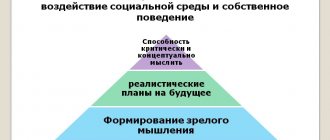Concept
Psychological self-regulation is an objective assessment of the situation, directed activity that allows you to control your own activity and correct the results of your actions.
There are two types of psychological self-defense:
- Involuntary - natural defense mechanisms that come from the subconscious. Focused on survival.
- Voluntary - conscious control of actions to achieve a set goal.
Self-regulation itself is formed throughout life, but self-awareness stops developing when a person stops learning responsibility and abandons self-development. Because of this, self-regulation suffers.
In adulthood, control over emotions is exercised by the intellect and is at its highest point. As we age, this balance shifts toward emotions. Because of this, psychologists compare old people with children.
Self-regulation depends on several factors:
- set goals;
- personality traits;
- environmental conditions;
- relationships between the subject and the surrounding world.
It is impossible to establish productive activities without a set goal; for this you need to additionally learn to control emotions.
Breathing technique for self-regulation of the body
You can easily master these exercises and gain experience in relaxation (relaxation), self-soothing in critical and stressful situations
You can easily master these exercises and gain experience in relaxation (relaxation), self-soothing in critical and stressful situations, use them to activate your condition, and also use them for preventive purposes . After all, it is known that a disease is easier to prevent than to cure.
Subscribe to our INSTAGRAM account!
These exercises can be performed in the morning after waking up. Additionally, you can exercise during the day. Duration 10–15 minutes. Do not cross your arms and legs. Close your eyes so that visual (visual) information does not interfere with your concentration. Breathe through your nose, lips slightly closed (not compressed at all).
Self-regulation exercise
1. Take a comfortable position, close your eyes, relax all the muscles of your body..
Mentally check the general relaxation, especially of the facial muscles (release clamps, unclench your jaws, make your face weak-willed, kind in expression).
Then mentally say the formula three times : I (as I inhale)… RELAX (as I exhale)... And (as I inhale)... I CALM DOWN (as I exhale).
2. Lie quietly for about 2 minutes, eyes closed.
Mentally focus only on your breathing.
Observe the process of your breathing: notice how your chest smoothly rises as you inhale and slowly falls as you exhale, how your lungs expand and contract. Breathing is even and calm.
3. (Eyes closed.) Try to imagine the room you are in and try to mentally walk around the entire room (along the walls), and then mentally explore each part of your body, make a path along the entire perimeter of the body - from the top of your head to the tips of your toes and - back. Do the exercise calmly, do not rush.
The best publications in the Econet.ru Telegram channel. Subscribe!
4. Again, focus on your calm breathing for 1-2 minutes.
Pay close attention to your breathing, passively aware that you are breathing through your nose. Mentally note that the inhaled air is slightly colder than the exhaled air.
Try not to think about anything else. Concentrate all your attention on your body and breathing. Do it with love and self-care!
5. Take a moderate deep breath and hold your breath for a moment.
At the same time, sharply tense all the muscles of the body for 5-10 seconds, trying to feel the tension throughout the body.
Then slowly, slowly, calmly exhale while relaxing your muscles.
After relaxing, breathe calmly, in your usual rhythm. Repeat this part of the exercise 3 to 7 times.
6. Mentally “run” through all the muscles of the body and check if there is any tension left anywhere . If yes, then try to remove it, since relaxation should be complete.
7. When completing the exercises, take a very deep breath . Hold the air for a moment and tense the muscles of the body, then exhale sharply, relaxing.
Breathe calmly, returning to normal breathing. Repeat 3 times.
8. Now open your eyes, then close your eyes several times, open them again and stretch sweetly. SMILE. Stand up very slowly, without jerking, without sudden movements, trying to maintain a pleasant feeling of inner relaxation and peace for as long as possible.
It should be remembered that the effectiveness of the exercises depends on the correct, positive emotional attitude.
The method cannot be reduced to mechanical execution of exercises.
It is necessary to “get used to” it, learn to identify your physical functions with the formulas of self-hypnosis. published
©Olga Rodionova, from the book “Back and Spine Health. Encyclopedia"
If you have any questions on this topic, ask them to the experts and readers of our project here
PS And remember, just by changing your consciousness, we are changing the world together! © econet
History of the discovery of the ability
The first scientist who made a great contribution to the discovery and further development of this skill was I.P. Pavlov. He learned to artificially influence the blood pressure of animals and change it using several methods:
- small cuts;
- introduction of various substances into the blood;
- nerve irritation.
He proved that after a change in blood pressure, it is enough to wait a little for it to recover. Thanks to this, the principle of self-regulation was developed. With the help of further research, the scientist found that this principle applies to all functions of the body.
Functions and mechanisms
There are different self-defense mechanisms with a similar principle of operation. They act at the levels of organs and cells.
The main function of the method is to change mental activity, allowing the subject to achieve a state of balance and harmony. Thanks to this, a person can perform several actions:
- cope with any adversity that arises throughout life;
- control your condition in various conflict situations;
- restore your own strength;
- think rationally under stress.
Theories and levels
There are several current theories of self-regulation, each of which has certain features.
System-activity regulation
Its author is L. G. Dikaya. It is simultaneously considered as a system and an activity. The author identified 4 levels of self-regulation:
- Involuntary - regulations that are based on activity that manifests itself during inhibition and excitement of the psyche. The individual cannot control involuntary reactions, but their duration is short-lived.
- Conscious - due to constant discomfort, a person faces the choice of developing self-regulation or performing some action to get out of the current situation. He sets priorities, changes the value of needs, evaluates motives. At the same time, self-programming, self-persuasion, self-hypnosis, introspection, and self-order begin to work. Personal and cognitive changes occur.
- Conscious regulation. The person feels discomfort and can realize the level of negative state. After realizing the situation, the subject makes a choice between ways to change his own state. This can be a manifestation of willpower, auto-training, psychophysical exercises, self-control.
- Arbitrary level. Self-regulation manifests itself only under severe stress and extreme fatigue. This may include holding your breath, muscle tension, convulsions, speech activity, emotions, gestures that cannot be controlled.
System-functional theory
Its author is A. O. Prokhorov. He viewed the processes of self-regulation as a change in mental states from one to another. Manifests itself in two ways:
- The functional structure of the processes of regulation of mental state develops gradually.
- The subject uses conscious methods of regulation to achieve the required state. To complete the task, the subject goes through several intermediate states.
The success of the technique is influenced by the adequacy of the image that was presented and the degree of awareness of the current state. To describe the current situation, several factors must be taken into account:
- breathing rhythm;
- bodily sensations;
- thoughts, feelings;
- imagination, memories;
- perception of time and space.
After accurately understanding the current situation, you can develop a technique for transitioning from a negative state to a necessary one.
Natural ways
In fact, self-regulation is not originally a human invention. In nature or by observing domestic animals, we can note a fairly large number of ways to help relax or activate the vital forces of the body.
Watch cats, for example. There is a lot to learn from them. In their behavior you can see the simplest, but no less effective techniques.
Dream.
The most desired, most favorite method among many, many residents of modern megacities. Sleep has a truly magical effect. During sleep, the body recovers.
A well-rested person reacts differently to stressful situations than a sleep-deprived person.
It often happens that a person suffers not from the quality of sleep itself, but from “bad” disturbing dreams. Having seen something strange and difficult to explain in a dream, a person does not understand how to interpret what he saw. Uncertainty may make him feel anxious. I may surprise you by saying that not every bad dream has a negative meaning. Some dreams that have a negative connotation help to express negative emotions that did not find a way out during the day. Thus, they save you from psychosomatic manifestations of stress. Other dreams, if interpreted correctly, clearly indicate certain areas of your life that require special attention and special elaboration. You can learn more about the influence of dreams by signing up for my online training, in which I reveal the secrets of the human subconscious through dream analysis.
High quality delicious food.
Another great way. In terms of its positive effect on the emotional state of your favorite dishes, it is always unrivaled. If it were not for the consequences of weight gain, this method of self-regulation would be ideal. . But here's what else is important to pay attention to.
In terms of its positive effect on the emotional state of your favorite dishes, it is always unrivaled. If it were not for the consequences of weight gain, this method of self-regulation would be ideal. . But here's what else is important to pay attention to.
During times of stress, the body spends much more energy, vitamins, minerals and trace elements than in calmer times.
And if for short-term stress a balanced, nutritious diet is quite enough, then for a long-term stress load the nutrition should be somewhat special. This topic is not simple and requires separate consideration, which will be in the following articles.
And now I’ll just draw your attention to the fact that during such periods the body especially needs magnesium, vitamin C, and B vitamins. That’s why we are so drawn to chocolate during times of stress - because cocoa beans contain a large amount of magnesium. But regular buckwheat also contains both magnesium and vitamin B-6. Just like the drug advertised on TV, only with the high bioavailability of a natural product.
Sunbathing.
Everyone has probably noticed that with the onset of spring and the appearance of the sun in the sky, the mood rises by itself. This is no accident. After the winter period, residents of our climatic conditions have time to truly “get hungry” for the sun’s rays.
Studies have shown that the “sunshine hormone,” as vitamin D is sometimes called, has a beneficial effect on the stress response. Namely, in the spring we feel the healing powers of sunbathing in a special way.
For safety, it is still important not to forget about sunscreen.
Pleasant movements for the body.
Stretching, leisurely walks, dance moves. All this helps us create emotional and physical comfort in our body. In this way, we learn to better feel our body and understand its reactions.
And then the body itself tells you what movements and what intensity it needs.
For example, if we cannot sit still during times of strong nervous excitement, then this is a clear “hint” that it is time to burn the stress hormones in the body through intense muscle tension. This could be visiting a fitness club or gym, cycling, swimming.
However, more ordinary exercise will help burn and remove hormones that have already served their role from the body - walking at a fast pace, and even cleaning the house, if done quickly.
Fresh air.
Remember those contrasting sensations when, after a noisy, dusty city, you go out into nature, for example, into the forest.
One hour of a leisurely walk in a forest can give the body enough strength for new victories and achievements.
There are a lot of natural ways of self-regulation, I have listed only the most popular of them. And here's what's interesting to notice. Often our body strives for them on its own, as if telling us the optimal way to restore the resource.
Features of ability depending on gender and age
Scientists have proven that women are more susceptible to the negative influence of fears, fatigue, anxiety, and irritation. Men experience stress, apathy, and loneliness within themselves, without sharing with others.
There are differences between the sexes in self-regulation. This is due to several factors:
- specifics of work;
- gender, cultural stereotypes;
- differences in education and upbringing of boys and girls;
- historical factors due to which the differentiation of social roles has developed.
Differences in the psychophysiology of women and men have a huge impact on regulation. Men's methods of self-regulation are biological in nature, while women's are social.
Certain features of monitoring one’s own psychological state relate to age. The younger a person is, the less control he has over his emotions. This is due to a lack of life experience, information accumulated over the years of life, and hormones. In adulthood, people reach their maximum level of self-regulation. With the aging process, emotions take their toll.
Techniques for controlling mental state first appear at 3 years of age. From this moment on, the child becomes aware of his Self.
Age-related manifestations of regulation:
- From 3 to 4 years old, motor and speech control techniques predominate in children, which manifest themselves involuntarily.
- From 4 to 5 years old - children learn emotional control through games. At this age, involuntary methods predominate.
- From 5 to 6 years old, the process of equalizing the proportions between involuntary and voluntary methods occurs. Thinking, imagination, speech, memory are actively developing.
- From 6 to 7 years old, children learn self-correction and self-control. Because of this, the proportions change. There is 1 involuntary method of regulation, 3 voluntary ones.
- Until the age of 20, adolescents develop acquired methods by actively learning from adults.
- From 20 to 40 years old, methods of self-regulation are chosen depending on what activity the person is engaged in.
- 40-60 years - passive rest, reading books, reflections are replacing the chosen methods of regulation.
- 60 years - communication, comprehension of the past, and passive relaxation begin to predominate.
The development of self-control techniques is greatly influenced by the social status and activity of the individual.
What is mental self-regulation?
Mental self-regulation is a person’s control of his psycho-emotional state, which is achieved through a person’s influence on himself through the power of words (affirmations), mental images (visualization) and control of breathing and muscle tone (relaxation). Self-regulation methods are used in absolutely any situation, and they always produce the desired effect.
Thus, among the effects of mental self-regulation, three main ones can be distinguished:
- Activation associated with increased psychophysiological activity
- Recovery associated with reduced symptoms of fatigue
- Calmness associated with the elimination of emotional tension
In general, there are, of course, natural methods of mental self-regulation, including:
- Music
- Dancing
- Movement
- Massage
- Interaction with nature and animals
- Food
- Dream
However, these funds cannot be used in many situations, for example, during work, when a person feels tired and observes tension in his mental state.
But it is precisely timely mental self-regulation that can be perceived as a psychohygienic means that can prevent the accumulation of overstrain, restore strength, normalize the psycho-emotional state and mobilize the body's resources.
For this reason, the most accessible methods of natural self-regulation are also:
- Expressing compliments, praise, etc.
- Breathing fresh air
- Real or imagined bathing in the sun
- Concentrating on pleasant things, photographs and flowers
- Contemplation of landscapes and panoramas
- Muscle relaxation, stretching and other similar movements
- Reflections on the pleasant and good
- Humor, smile, laughter, etc.
But, in addition to natural ones, there are special methods of self-regulation, which in some cases are also called self-influence. It is about them that will be discussed further.
Methods and techniques
People use different methods of self-regulation:
- meditation;
- relaxation;
- self-hypnosis;
- desensitization;
- autogenic training;
- reactive relaxation.
Relaxation
This technique can be voluntary or involuntary. When performing a free technique, the subject takes a relaxing pose and imagines a place in which he would be comfortable. Relaxation helps achieve several goals:
- restoring the body's energy;
- general health;
- relieving muscle tension;
- restoring mental balance.
The complex effect allows you to improve the general condition of the individual.
Desensitization
A technique used to get rid of anxiety and fear. There are several methods of desensitization:
- Relaxation. You need to calm down, scroll through disturbing situations in your thoughts. Repeated awareness allows you to get rid of fears and anxiety.
- Breath control. To regain freedom of action, you need to breathe calmly in a negative situation.
Another way is to eliminate fears with the help of pleasant impressions and new emotions.
Autogenic training
They were first proposed by a doctor from Germany, Schultz. Their principle is self-hypnosis. The techniques can be mastered through systematic exercises. The techniques are available to anyone. Thanks to training, you can cope with stress, strengthen strong-willed qualities, and normalize the emotional sphere.
Popular methods:
- To fill the capillaries with blood, you can think about heat, to relax the muscles - imagine lifting weights.
- Training to master the correct breathing technique. To do this, a person experiences a feeling of heaviness and warmth. They suggest to him that the heart rhythm is even. Once the subject is prepared, he should begin to repeat the phrase “I am calm.”
With the help of self-hypnosis, you can control your emotions and change your own state.
Meditation
The practice of meditation allows a person to relax, relieve emotional stress and fatigue. To carry it out, you need to allocate about 20 minutes every day. There are 2 types of meditation:
- relaxation;
- immersion in deep thought.
People who regularly practice meditation note its positive effects on the body.
In addition to the practices discussed, there are several methods of natural regulation:
- visiting literary evenings;
- listening to classical music;
- walks in the forest;
- intensive training, morning exercises;
- daily morning jogging;
- hardening;
- communication with charismatic people.
Some write down their experiences and negative emotions in a diary and analyze them. This helps to get rid of internal worries. It is important to use the techniques consciously.
Everyone has faced negative situations. A change in psychological state can lead to devastating consequences. To resolve conflict situations without a bad outcome, you need to learn self-regulation.
Methods of self-regulation associated with breathing
Breath control is a very effective means of influencing muscle tone and emotional brain centers. If you breathe slowly and deeply (abdominal breathing), the excitability of the nerve centers decreases, and a state of relaxation occurs. If you breathe exclusively through the chest, then the highest degree of activity of the body is ensured and neuropsychic tension is maintained.
Next, we present one of the simplest and most effective methods of respiratory self-regulation:
- You need to sit down, take a comfortable body position and focus on breathing
- While counting to four, you should take a deep and slow breath (use abdominal breathing)
- Then you need to hold your breath and also count to four.
- After this, you need to exhale smoothly, counting to six.
- Next, you need to hold your breath again, counting to four.
After just five minutes of doing this breathing exercise, you will notice that your state has become more balanced and calm.
Methods of mental self-regulation can and should be used daily at any moment when you begin to feel fatigue, tension, irritability, loss of strength, emotional decline and other similar conditions. In fact, such methods of influencing a person on himself are an excellent way to always be in a cheerful state and in a good mood, regardless of the characteristics of current situations.
YOUR WAYS OF SELF-REGULATION: Among other things, it is very interesting that each person has his own methods of mental self-regulation, i.e. those methods that suit him best. However, finding out which ones are effective and which ones are not very effective can be quite difficult - this requires a lot of practice and knowledge of the characteristics of one’s personality. But today we offer you an excellent opportunity to go through the first stage in a very short time and learn enough information about yourself to develop the most effective method of self-regulation for yourself, the use of which will serve you very well in life. This way is our course on self-knowledge, which you can find here.
Start self-knowledge, and we wish you good luck and always be in the best condition for yourself!
We also recommend reading:
- Storytelling
- Psychic reflection
- Surprising facts about stress
- Ways to relieve stress
- Anger: causes and overcoming
- Properties of mental states
- Emotional Intelligence in Leadership
- Enemies of good decisions
- Systematic desensitization of Joseph Wolpe
- Eight Strategies to Improve Self-Regulation
- Common complexes and overcoming them. Part 2
Key words:1Psychoregulation










